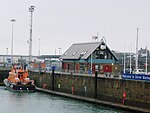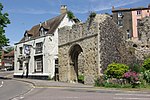Admiralty Pier Turret
Buildings and structures completed in 1882Bunkers in the United KingdomCoastal artilleryForts in Dover, KentUse British English from February 2018

The Admiralty Pier Turret, or Dover Turret, is an enclosed armoured turret built in 1882 on the western breakwater of Dover Harbour in southeast England. It contains two Fraser RML 16 inch 80 ton guns, the biggest installed in the United Kingdom. Declared obsolete in 1902, it is currently part of the port and inaccessible, though the guns remain in place.
Excerpt from the Wikipedia article Admiralty Pier Turret (License: CC BY-SA 3.0, Authors, Images).Admiralty Pier Turret
Lord Warden Square,
Geographical coordinates (GPS) Address External links Nearby Places Show on map
Geographical coordinates (GPS)
| Latitude | Longitude |
|---|---|
| N 51.111666666667 ° | E 1.3188888888889 ° |
Address
Admiralty Pier Turret (Dover Turret)
Lord Warden Square
CT17 9EQ , Clarendon
England, United Kingdom
Open on Google Maps










